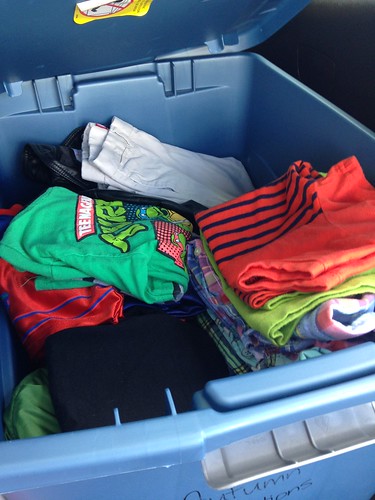
8 Tips and Tricks to Consigning Kids Clothing
I started consigning my kids clothes about two years ago. I tried once when I lived in Connecticut, but the first try was a mess. Nothing of mine was bought by the store and I was so frustrated and offended that it took me YEARS before I was ready to try again. Now that I’ve been doing it a while, I thought I’d share some tips and tricks that have brought me the best returns:
1. Have a system in your house for storing consignment clothing. In each of the kids’ closets, I have a big Rubbermaid bin for consignment/giveaway clothes. The trick is that you only put clothing in there when it is clean. Consignment stores only buy what they think they can sell, and clean is #1 on their lists. If I see the kids put something on that is too small, we put it into the consignment bin right away. This means I don’t have to wash everything again before I take it in to consign. It also makes sorting for a consignment run really quick.
2. Consign seasonally. Most consignment store don’t have the room to store clothing for year-round seasons, so they only purchase clothing that is currently in season or is about to be in season. For this reason, I save things until they are back in season again before I consign them. So, Bean’s jeans and pants from LAST winter are just now being consigned this weekend because cooler weather is back. I’ll save the shorts and bathing suits he just grew out of until about March/April before I consign those. Typically, consignment stores don’t want clothing that is too old or out of date, but I have found that they will take things that are just a season out of date. Also on the list for consigning right now: Halloween costumes!
(Spider Man, a dinosaur, a tiger, a bumble bee, and Buzz Lightyear are in this pile somewhere…)
3. Be choosy when you are deciding what to consign. Only take in items that you would buy again. Don’t take them every piece of clothing your kids have outgrown. Only take in items that you yourself would buy again. Consignment clerks are overwhelmed with goods. Spend a few minutes watching them pilfer through someone’s clothing and you’ll see that they are quick to throw things to the side if they look worn, stained, or dirty. Keep in mind when they go through your things, they are looking quickly. If 75% of what you have is not great quality stuff, they won’t pay much attention to the other 25% that IS quality. But if you bring in a basket where 75% is good quality, they are more likely to take your whole basket more seriously. Also, I have found that bringing in poor quality clothing (like the quality that you might donate somewhere) can be insulting to a shop owner. Bringing quality items says that you know they only SELL quality items.
4. Organize your items when you take them in and make it easy for the clerk to go through them. I try to limit myself to my one Rubbermaid tub of clothing for each trip. Any more than that and the clerks get a little overwhelmed and just gloss over my offering. One good-sized bin is just enough. And sort your items by clothing type. I’ll put all the shorts together, all the short-sleeved shirts together, all the long-sleeved shirts together, all the dresses together, etc. This makes it easier for the clerk to find what they know they are buying and to put aside automatically what they know they aren’t purchasing right then. The exception to this would be any sets that go together. Consigners will only buy complete outfits if the item goes with a set. They won’t buy random bloomers without the dress that it is supposed to go with, or buy a dress without the bloomers that are sold with it. So, keep those sets together. Lastly, be sure to fold things neatly. The trick is to make your items look well-cared for. Winkled, mismatched clothing shoved into a garbage bag does not look appealing to a consignment store.
5. Know what they like and what they don’t like. Any good-quality items with popular characters on them usually sell really well. So do pajama sets, and especially pajamas with the pants and button-up shirts (the kind they sell in gift sets at Christmas). Shoes are always a good item to bring, but they typically check to make sure the soles are not worn, so skip any that are exceptionally “loved.” I find Sunday dress shoes to be the best because my kids didn’t wear them daily, so they are still in pretty good shape. They also prefer name brands over generics (my kids had a lot of the Granimals line from Walmart and the Cherokee line from Target, but those never sell very well where I consign…). I try to only take the top of the line things. Pants, jeans, dresses, sweaters, nice tops, good quality shoes, etc.
6. Go to the same store every time. If you go to the same place consistently, they get to know you a little bit and they go into your basket of goods knowing the quality of merchandise you bring in. I have been using the same place (even though it is all the way across town from where I live!) for two years, and now they recognize me when I come in and I tend to get more purchases than when I was a customer who happened to wander in and not know what I was doing. Now, they recognize that I know what they are looking for and so they tend to appreciate my basket more now than before.
7. Don’t take it personally when your things are not purchased. There are a lot of factors that influence what is purchased and what is not. Seasons, supply and demand, room in their store, what they currently have already, what is selling, what is not, and the list goes on. They might LOVE what you have, but they don’t purchase it because they already have three of the exact same item on their shelves. Which brings us to the last:
8. Set your expectations really LOW. Consigning is not how you are typically going to make a LOT of money. Expect them to purchase about 25% of what you bring and pay about 25% of what you paid – and then be delighted if you get more. So, why consign then? I like consigning because I get more for the things that I paid more for than if I were to put it in a yard sale or something like that. On average, I make about four/five clothing consignment trips a year (toy consignment is a little different) and I make $75-100 each trip, depending on what I bring. It’s not a lot, but it’s also not a lot of effort and I make a little Christmas money with each trip.
You can also consign children’s toys, too. I usually make separate trips for those, only because I typically have a lot of clothes to consign in one trip and I don’t want to “water down” my clothing items with toys. I want the clerk to focus on my clothing items, so I bring those separately. Except, of course, for the one trip when I actually take the picture for my blog post. I took this giant playmat to consign along with all the clothing this time. Sold it, too!
With toys, make sure that you have all the pieces that come with the toy set. For example, if your race track came with two cars, don’t bring in just the track. Or, if the bowling pin set is short a pin, don’t consign it. Also, give your toys a good clean before consigning them. Wipe away any dust (or dog hair, in my house!) and clean off any stains. The toys should look like they came from the store, but without the box they came in.
Consigning is not where I plan to make any money, but it is a nice way to make a little extra cash – especially this time of year when Christmas is right around the corner. I also use our spring consignment money for our summer fun fund. But if you are going to consign, be sure you do it intentionally and with a very picky eye. Know what they are looking for and remember that you are trying to CONVINCE them to purchase your items. Presentation is key!
Happy consigning!






5 Comments
Maybelline @ Naturalmente Mamá
Great tips! Thank you for sharing!
JustAng
That mat is our best purchase ever. I would have LOVED to find it at the consignment store!! Someone got lucky!
Lee Ann
My bits of advice: Know the rules of the store before you arrive. My consignment store will only look at items on a hanger (easier for them to see). They also have a 20-piece limit for each time you come in to consign. Knowing the shop’s policies make it easier to do a quick trade. Good luck!
Verity
I have no idea what a consignment store is! Is it a nearly new or seconds shop? Can you also give clothes direct to charity shops for free? And do they buy it from you then and there or do you get money later when it sells?
Christy
This will definitely come in handy in the future. My baby girl is due at the end of January and I can’t control myself at baby consignment stores. I want to go back…now.